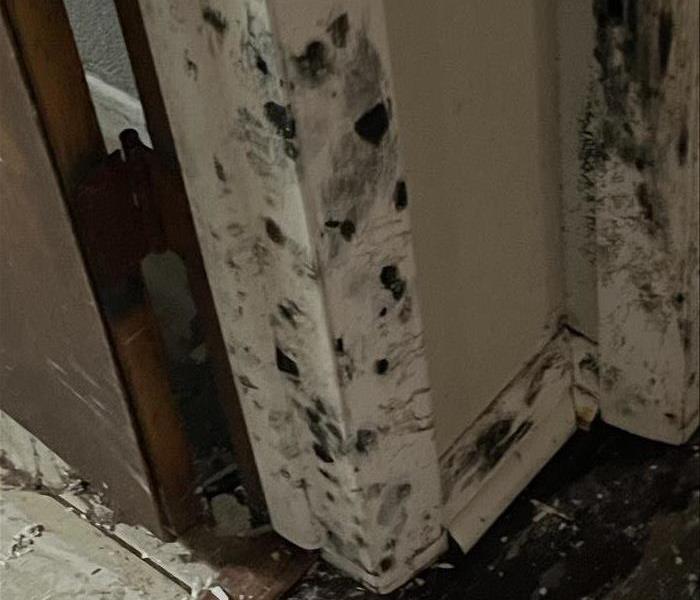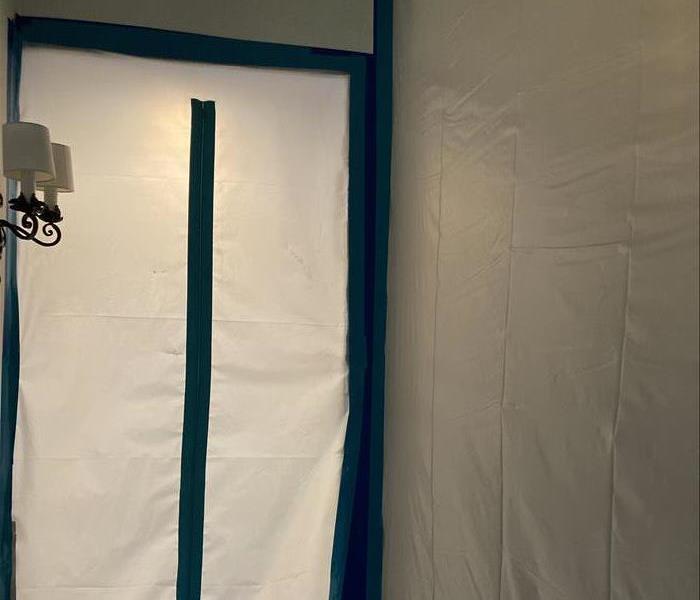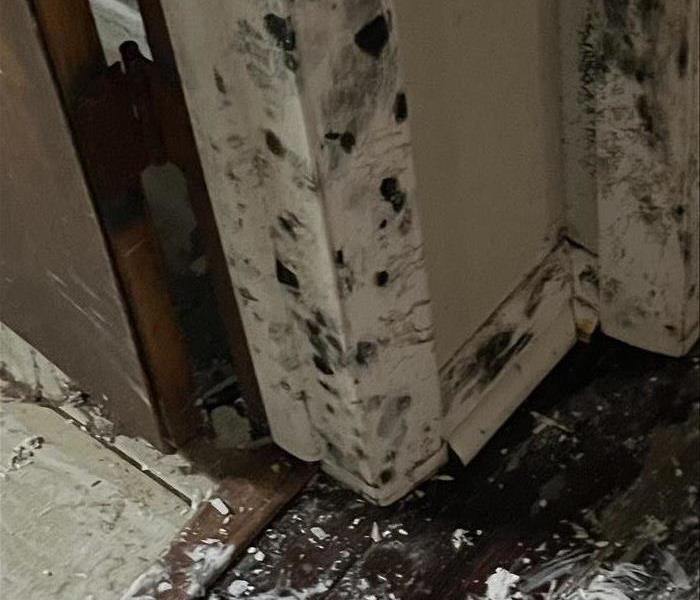Recent Mold Remediation Posts
Mold in Commercial Buildings: Protecting Your Business from Damage
11/13/2024 (Permalink)
Mold in commercial buildings is more than just an unsightly problem; it can have serious implications for business operations, property value, and overall employee and customer experience. Left unchecked, mold growth can cause structural damage, create unpleasant odors, and lead to costly repairs. Commercial building owners and managers must prioritize mold prevention and remediation to protect their business investments.
SERVPRO of Bel Air/ West Hollywood, a leader in mold remediation services, is well-equipped to help businesses tackle mold issues and prevent them from causing long-term damage. Here's a look at how mold impacts commercial buildings and the solutions SERVPRO® offers.
How Mold Develops in Commercial Buildings
Mold thrives in environments with excess moisture, such as areas affected by water leaks, high humidity, or poor ventilation. In commercial buildings, mold often develops in places that may go unnoticed, such as basements, crawl spaces, behind walls, or in HVAC systems.
Common causes of mold in commercial buildings include:
- Leaky pipes or plumbing issues: Undetected leaks can provide the moisture mold needs to grow.
- Roof or window leaks: Water can seep into the building through damaged roofs or poorly sealed windows.
- Poor ventilation: In large commercial spaces, inadequate ventilation systems can trap moisture in the air.
- HVAC systems: Air ducts and HVAC systems that are not regularly cleaned or maintained can become breeding grounds for mold spores.
- Flooding or water damage: If water damage from storms or floods is not properly mitigated, mold can quickly take hold.
The Impact of Mold on Business
- Structural Damage: Mold can cause severe damage to the structure of a commercial building. It can eat away at materials like wood, drywall, and insulation, weakening the integrity of walls, floors, and ceilings. Over time, this damage can require expensive repairs and even lead to parts of the building being deemed unsafe for use.
- Operational Disruptions: Mold infestations often require businesses to temporarily close or limit access to certain areas of the building while remediation is underway. This can disrupt daily operations, leading to lost productivity and revenue.
- Damage to Property and Inventory: In retail or warehouse settings, mold can affect stored goods and inventory, leading to spoilage or loss. This not only impacts the bottom line but also affects customer satisfaction.
- Unpleasant Odors and Poor Air Quality: Mold often produces musty odors, which can be off-putting to both employees and customers. Poor indoor air quality due to mold spores can create an uncomfortable environment and harm a business's reputation.
- Legal and Compliance Issues: Building owners are responsible for maintaining a safe and habitable environment for tenants and employees. Failing to address mold issues can result in legal liability, fines, or non-compliance with building codes and regulations.
Preventing Mold in Commercial Buildings
To prevent mold from becoming a costly problem, commercial building owners should prioritize maintenance and moisture control. Key preventive measures include:
- Routine Inspections: Regularly check for signs of water leaks, damp areas, and humidity issues. Early detection is critical to preventing mold growth.
- Proper Ventilation: Ensure HVAC systems are properly maintained and that air flows freely throughout the building. This can help prevent moisture buildup.
- Humidity Control: Keep indoor humidity levels below 60% using dehumidifiers and monitoring systems in high-moisture areas.
- Prompt Water Damage Response: Address any water damage immediately. Businesses should work with professionals like SERVPRO to properly mitigate water damage and prevent mold from developing.
- HVAC Maintenance: Regularly clean and service HVAC systems to prevent mold spores from circulating through the air.
SERVPRO: The Mold Remediation Experts
When mold is discovered in a commercial building, it’s essential to act quickly to prevent further damage. SERVPRO specializes in mold remediation, providing businesses with expert solutions to identify, contain, and eliminate mold problems.
SERVPRO uses advanced techniques to thoroughly clean and restore affected areas, ensuring mold doesn’t return. Their professional team also helps identify the root cause of mold, such as water leaks or humidity issues, to ensure long-term prevention.
By working with SERVPRO, business owners can minimize downtime, protect their property. Don't let mold jeopardize your business—call SERVPRO of Bel Air/ West Hollywood for expert mold remediation services tailored to the unique needs of commercial properties.
Everything You Need to Know About Mold in Crawl Spaces
7/17/2024 (Permalink)
 Mold in your crawl space can cause significant property damage.
Mold in your crawl space can cause significant property damage.
Mold in your crawl space is a serious problem that can lead to property damage and unpleasant odors in your home. Addressing this issue promptly is crucial to maintaining a healthy and safe living environment. In this blog, we'll explore how mold gets into crawl spaces, how to prevent it, and the steps you can take to remove it if it appears.
How Does Mold Get Into Crawl Spaces?
Crawl spaces are prone to mold growth due to their dark, damp, and poorly ventilated nature. Mold spores can easily find their way into your crawl space through various means, such as:
- Moisture Infiltration
Water can enter crawl spaces through cracks in the foundation, plumbing leaks, or from the ground if the area is not properly sealed. Excess moisture creates the perfect environment for mold to thrive.
- Poor Ventilation
Inadequate ventilation in crawl spaces traps moisture, creating a humid environment that encourages mold growth. Without proper airflow, the area remains damp, providing a breeding ground for mold.
- Organic Materials
Crawl spaces often contain organic materials like wood and insulation, which can serve as food sources for mold. When these materials become damp, mold can quickly colonize them.
Preventing Mold in Crawl Spaces
Preventing mold growth in your crawl space involves controlling moisture and ensuring proper ventilation. Here are some effective strategies:
- Control Moisture
Ensure that your crawl space remains dry by addressing any water intrusion issues. This includes fixing leaks, sealing foundation cracks, and ensuring proper drainage around your home's perimeter. Installing a vapor barrier on the crawl space floor can also help prevent moisture from seeping in from the ground.
- Improve Ventilation
Proper ventilation is crucial in preventing mold growth. Install vents or exhaust fans to promote airflow and reduce humidity levels. Ensuring that your crawl space has adequate ventilation helps to keep the area dry and mold-free.
- Use a Dehumidifier
If your crawl space is prone to high humidity, consider using a dehumidifier. This device can help maintain low humidity levels, making it difficult for mold to grow. Regularly monitor and adjust the dehumidifier to ensure optimal performance.
- Insulate Your Crawl Space
Proper insulation can help control temperature and moisture levels in your crawl space. Use moisture-resistant insulation materials to reduce the risk of mold growth. Ensure that insulation is installed correctly to avoid trapping moisture.
Removing Mold from Crawl Spaces
If you discover mold in your crawl space, it's important to act quickly to remove it. Here are the steps to effectively eliminate mold:
- Wear Protective Gear
Before starting the cleanup process, wear protective gear such as gloves, goggles, and a mask to avoid exposure to mold spores.
- Identify and Fix Moisture Sources
Identify and repair any sources of moisture to prevent future mold growth. This may involve fixing leaks, sealing cracks, and improving drainage.
- Clean the Affected Area
Use a mold removal solution to clean the affected areas. You can use a mixture of water and detergent or a commercial mold cleaner. Scrub the moldy surfaces thoroughly to remove all traces of mold.
- Dispose of Contaminated Materials
Remove and dispose of any contaminated materials such as insulation or wood that cannot be cleaned effectively. Replace these materials with mold-resistant alternatives.
- Dry the Area Completely
Ensure that the crawl space is completely dry after cleaning. Use fans or dehumidifiers to speed up the drying process. Properly drying the area is crucial to prevent mold from returning.
- Monitor and Maintain
Regularly inspect your crawl space for signs of moisture and mold. Implement preventive measures and conduct routine maintenance to keep the area dry and mold-free.
Mold in your crawl space can cause significant property damage and create an unpleasant environment in your home. By understanding how mold gets into crawl spaces and taking proactive steps to prevent it, you can protect your home and ensure a safe living space. If you discover mold in your crawl space, act quickly to remove it and address the underlying moisture issues. For professional assistance, consider contacting a mold remediation service like SERVPRO® to ensure thorough and effective mold removal.
How Water Damage and Mold Go Hand in Hand
3/15/2024 (Permalink)
 Understanding this dynamic duo is key to addressing water damage promptly and mitigating the risk of mold growth in your home.
Understanding this dynamic duo is key to addressing water damage promptly and mitigating the risk of mold growth in your home.
Water damage in residential settings is more than just an inconvenience; it often brings an unwelcome companion — mold. In this blog, we'll delve into why residential water damage and mold seem to go hand in hand, shedding light on the interconnected issues that homeowners may face. Understanding this dynamic duo is key to addressing water damage promptly and mitigating the risk of mold growth in your home.
1. Moisture as the Catalyst
Water damage creates the ideal breeding ground for mold by introducing excess moisture into the equation. Whether it's a burst pipe, roof leak, or flooding, the lingering moisture becomes a catalyst for mold spores to thrive and multiply.
2. Timing is Everything
Mold is opportunistic and swift, often appearing within 24 to 48 hours after water damage occurs. The quick onset of mold growth highlights the urgency of addressing water damage quickly to prevent a potential mold infestation.
3. Hidden Havens for Mold
Water damage doesn't just affect visible surfaces; it can seep into hidden nooks and crannies, under flooring and behind walls, providing secluded areas for mold to grow. This makes it essential to thoroughly assess and address water damage to prevent mold from establishing hidden colonies.
4. Material Matters
Certain building materials, such as drywall and insulation, are particularly susceptible to water absorption. Once saturated, these materials become a breeding ground for mold. Understanding the materials in your home and their vulnerability to water damage is crucial in preventing mold issues.
5. Neglected Spaces
Areas that often go unnoticed, like basements, crawl spaces, and attics, are more susceptible to water damage and subsequent mold growth. Regular inspections of these neglected spaces can help identify and address water damage before mold has a chance to take hold.
6. Humidity Amplifies Mold Risk
After water damage occurs, the residual humidity in the air can further amplify the risk of mold growth. Adequate ventilation and dehumidification are essential in reducing humidity levels and mitigating the potential for mold infestation.
7. DIY Cleanup Risks
While DIY water damage cleanup may seem cost-effective, improper drying and cleaning techniques can leave lingering moisture, setting the stage for mold growth. Professional water damage restoration services ensure thorough and effective cleanup, minimizing the risk of subsequent mold issues.
8. Continuous Monitoring
Even after water damage is addressed, continuous monitoring is crucial. Regular checks for signs of mold growth, such as musty odors or visible patches, can help catch potential issues early and prevent widespread infestation.
Understanding the relationship between residential water damage and mold empowers homeowners to take proactive steps to protect their homes. Prompt attention to water damage, thorough cleanup, and ongoing monitoring are key elements in breaking the cycle and maintaining a mold-free living environment.
Mold Removal Safety: Protecting Your Employees in the Workplace
6/8/2023 (Permalink)
Mold is a fungus that grows in damp areas, such as bathrooms and basements. It's important to make sure your employees are safe during mold removal.
If you have any questions about this guide or would like more information on how we can help with your business needs.
Mold Removal Safety Tips
- Wear protective gear.
- Use proper ventilation.
- Utilize professional help, if necessary
- Create a Safe Environment
Create a safe environment
Identify problem areas. Look for the places in your office where mold is likely to grow, such as bathrooms and kitchens. Contain the mold. If you can't remove it all at once, try to contain it with plastic sheeting or tape until you have time to come back with proper equipment and supplies (see below).
Use the right cleaning materials
Be sure that whatever products you use are safe for people who may be sensitive to chemicals like bleach or ammonia-based cleaners; you can also use an alternative product like vinegar instead of bleach when cleaning up after a major spillage of water from flooding and rain
Take Precautions
To ensure your employees' safety, you should:
- Train your employees on the proper safety procedures for mold removal. They should know how to test the air quality and provide proper ventilation.
- Make sure that everyone wears protective gear when working around moldy areas of the building. This includes goggles and gloves made from natural materials like cotton or latex (not synthetic materials like nitrile).
Monitor Progress
In addition to checking for signs of mold growth, you should also check the air quality regularly. You can do this by using an inspection checklist and testing it at least once a month. It's important that you keep track of any changes in your building's environment so that if there is an issue with mold growth, you can address it quickly.
Provide Personal Protective Equipment (PPE)
You should have a supply of disposable or washable coveralls, gloves and face masks for workers to use during the removal process. If you are using respirators, make sure they are properly fitted and maintained according to manufacturer's instructions.
Follow OSHA Guidelines
If you're a small business owner, it may be tempting to skip the safety precautions and save money by doing the job yourself. However, this can have serious consequences for your employees and the future of your company. Provide training on how to handle these materials safely before starting any work involving them--and make sure everyone follows those instructions!
Dispose of Contaminated Materials Properly
If you're going to be removing mold and other contaminants from the workplace, it's important to know how to dispose of them properly. Molds and other fungi can be dangerous if they're not handled correctly--and even more so when they're allowed to spread throughout your building.
Prevent Future Mold Growth
Clean and dry damp areas. Use dehumidifiers to remove excess moisture from the air, especially in rooms that have been flooded or have had standing water for more than 48 hours. Repair any water leaks in your home or office building as soon as possible, if you can't repair them yourself, contact a professional plumber who can help fix the problem quickly and safely.
Now that you know the basics of mold removal and how it can affect your employees, it's time to review some safety guidelines. Review your company's safety policies with your employees. This is especially important if there are new regulations in place or if there are any changes from previous years' policies.






 24/7 Emergency Service
24/7 Emergency Service


